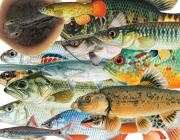This project has a very long history, beginning with work decades ago by eminent ichthyologist Robert R. Miller and his graduate student, Julian Humphries. They made substantive progress toward publishing a description of this still undescribed species from northern México, Texas and New Mexico. Dean was a peripheral player in that work way back in his grad student days, helping to provide specimens, etc., and because this species obviously had much in common with its a close relative, the Yaqui Catfish (another of Dean's old projects that has also seen a resurgance of activity in recent years). Julian's and Bob's work in the 1990s, though never published, was well enough known in the conservation world that this undescribed species found its way into the conservation literature, and eventually showed up on the US Fish and Wildlife Service's list of species that are candidates for listing as endangered. That then increased at least political interest in it and potentially opened some funding doors for conservation management.
The obvious first requirement for any consensus about conservation need, though, is taxonomic certainty that the candidate is indeed a species eligible for listing. So, we're now involved in trying to follow up on Humphrie's and Miller's earlier work to determine if this is indeed a valid species and, if so, formally publish a description of it. At the same time, we're working to update information about its conservation status. Neither task is as simple as it may sound, even though we have copies of near final description manuscripts produced by Julian Humphries (doctoral student) and Miller in the 1990s and early 2000s. As they recognized, the species is clearly rare in the U.S., where it occurred naturally only in the Río Grande basin, where they believed it likely extirpated, and, as they noted, it appears to hybridize with a couple of other catfish species (both native and introduced), which greatly complicates morphological analyses. Since most specimens were collected many years ago when standard practice was preservation in formalin, DNA that could help factor out the morphological noise attributed to hybridization, is not available from the specimens they studied. Perhaps relevant research will be facilitated by the November 2019 notice to file suit against the U.S. that was filed by the Center for Biological Diversity for failure to decide whether Chihuahua Catfish (and many other species) should be federally protected.
So, we're starting to pick up this project. It's slow going, but we're making some progress. The limited DNA we've obtained from newer specimens from both the Gila River in New Mexico and from near the location of the type locality in Julian's and Bob's manuscript, are closely related to the Headwater Catfish, with those from Chihuahua being slightly (2% divergent) from it. The genetics also support the hybridization hypotheses. Genetic ananalyses will clearly be key to resolving this long-standing mystery and clarifying the conservation status of both this species and Headwater Catfish. Dean presented an overview of this work (opens in new tab) at the 2017 Desert Fishes Council meeting in San Luis Río Colorado, Sonora, México, but we're still looking for funding to help get us further down the path toward solving this mystery. Meanwhile, little has happened to clarify the taxonomic staus of the still un-named form\. Miller and Humphries did not attempt genetic analyses, but recently, Alejandro Varela and colleagues analyzed tissues of specimens collected from near where Miller and Humphries collected what were destined to become the holotype and a large series of paratypes in the Río Nonoava of the Conchos basin. Their results, indicating it to be sister to Ictalurus lupus, were most recently summarized in a book chapter (Varela Romero, A., Ballesteros-Cordova, C. A., Ruiz-Campos, G., Sánchez González, S., & Brooks, J. E. (2020). Discoveries and Conservation of Catfishes in México. In D. Propst, J. Williams, K. Bestgen, & C. Hoagstrom (Eds.), Standing between Life and Extinction (Varela-Romero_etal_2020_RecentDiscoveries&Conservation-Ictalurus-Mexico_Chp19-StandingBetweenLife&Extinction.pdf; pp. 285–293). Desert Fishes Council, University of Chicago Press. https://chicago.universitypressscholarship.com/view/10.7208/chicago/9780226694504.001.0001/upso-9780226694337). Humphries and Miller noted considerable morhpological evidence of hybridization, and It seems likely that this species has a history of hybridization very much like that of the Yaqui Catfish (Ictalurus pricei), and if so, it's likely that the introgression has been going on for even longer than it has with Yaqui Catfish, which didn't start hybridizing with I. punctatus until humans introduced that species to the Yaqui sometime in the latter half of the 20th century.

